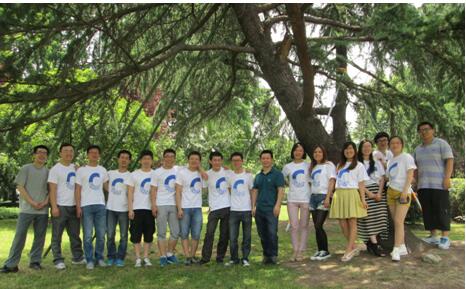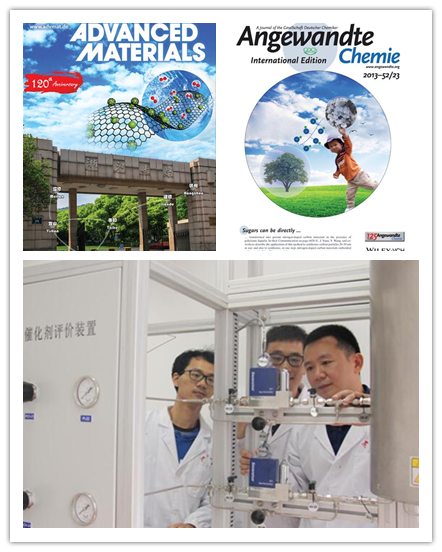Selective hydrogenation is one of the most important and challenging reaction in chemical industry, which is widely applied in pharmaceutical Factories. Catalysts are the core of the selective hydrogenation. Regarding the great challenges caused by the low activity, poor selectivity and stability of the industrial hydrogenation catalysts, such as Pd/C, Pt/C and so on, Prof. Wang Group was among the first who proposed a valid strategy to greatly improve the catalytic performance by introducing nitrogen doped hierarchically porous carbon as new supports to stabilize metal nanoparticles. And a series of methods to synthesis nitrogen doped hierarchically porous carbon materials have been successfully developed soon afterwards.
Prof. Wang Group has unfolded intimate cooperation with Zhejiang NHU Company Ltd. in production, education and research fields. According to specific hydrogenation requirements, a series of superior supported nano-catalysts were developed by precisely modification of the active sites and supports respectively. Several research findings have realized industrial application. Specifically, the successful large-scale application of nitrogen doped hierarchically porous carbonsupported Pd catalysts for the first time all over the word, has extended the application scope for carbon materials. The development of the frontier technology for catalysis and the large-scale application in industry have greatly enhanced the core competitive power of the enterprise, made significant contributions for energy conservation and emission reduction, and brought about considerable economic and social profits. The yield of vitamin E in Zhejiang NHU Company Ltd. have ranked No.1, surpassing BASF since 2016.

Decipherment of Our Research
Inspired by the bat, radars and sonars are invited; inspired by the wings of birds, gliders are invited; inspired by the air bladders in fishes, submarines are invited; come from life and then apply back. That is the motivation to advance the society from scientific research. At institute of catalysis in ZJU, inspired by the inner pore structures of bread, researchers conducted researches for preparation and application of nano catalysts based on nitrogen doped hierarchically porous carbon materials, and provided new motivity to upgrade for pharmaceutical manufacturers at the same time.
Years ago, people always connected chemical industry with high pollution and toxicity. However, the concept of green chemistry proposed recently requires to curb environmental pollution from the beginning. Therefore, pharmaceutical manufacturers in our province have to face the huge transformation pressure in recently years.
Then how to transform and upgrade for pharmaceutical manufacturers? In the perspective of Prof. Wang, catalyst design has been the key to determine whether this field can successfully upgrade or not. Traditional active carbon as catalyst support suffers from serious drawbacks, such as the poor availability of active components caused by micropores, the leaching caused by the weak interaction between carbon and the active sites and etc. Based on the above two defects, the carbon support was optimized accordingly. First, leavening method is used to introduce hierarchically porous structures. The induced meso- and macro-pores can greatly improve the availability of the active sites. Second, dope with nitrogen of higher electronegativity. Nitrogen doping can justify the local electron density of the carbon support, strengthen the interaction between the active centers and support, and then improve the activity and stability of the catalysts. The new developed catalyst has been successfully applied to the production of the key intermediate of vitamin H. compared with traditional Pd/AC catalyst, the new developed catalyst reduces the required amount of noble metal by ~80%, and can be reused beyond 15 times with simplified separation, significantly saving the cost.Thisproject is also supported by Zhejiang Provincial Natural Science Foundation of China.
However, it is not easy to modify the catalysts at nano or even atomic scale. Numerous trials didn’t make a substantial breakthrough, until we were inspired at breakfast once. “why not learn from bread?”, quoted from Prof. Wang, “After fermenting by NaHCO3, the baked bread owns plenty of honeycombed pores.”
Then Prof. Wang and group members went back to lab at once to testify the thought. Finally, utilizing carbonate to replace the caustic soda, we successfully manufactured nitrogen doped hierarchically porous carbon materials full of macro-, meso-and micro- pores from raw biomass in one step. This strategy is proved to be very economical and have great potential for large scale production.
Till now, the related research findings from Prof. Wang group has taken a first step to industrialize. During the cooperation with Zhejiang NHU Company Ltd. in production, education and research fields, the intimate combination between the key technology of catalysts and the right demands from company helps the rapid upgrade of this company.

Introduction about our team
Yong Wang received his BS degree from Xiangtan University and his PhD degree from Zhejiang University. After a postdoctoral stay at the Department of Chemistry, Zhejiang University, he joined the Max Planck Institute for Colloids and Interfaces in Potsdam/Germany in 2009. He rejoined Zhejiang University and became a Professor for Chemistry in 2011. Now he is Ph.D. supervisor, director of the Institute of catalysis at the Department of Chemistry in Zhejiang University. Prof. Wang also received supports from the national youth talent support program and National Natural Science Foundation of China Youth Fund. He is the co-author of 20 patents and over 100 journal articles with over 6,600 citations, including J. Am. Chem. Soc., Angew. Chem. Int. Ed., Nat. Commun., Energ. Environ. Sci., Adv. Mater., ACS Catal., J. Catal., and etc. Prof. Wang’s research grouphas been focusing on the basic science and applied research for the design and development of carbon basedheterogeneous catalysts. Several ones have been successfully applied in industry. They strive to pursue green energy technologies and the beautiful fundamental science that make these technologies a reality.